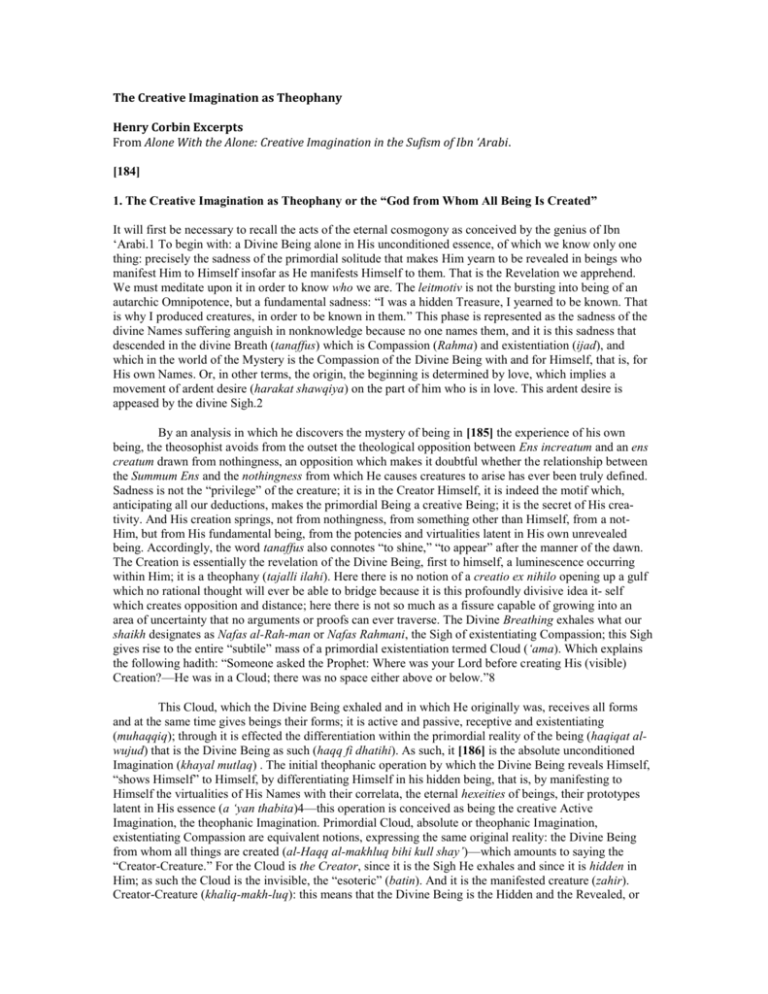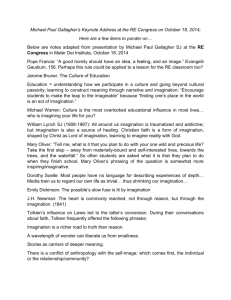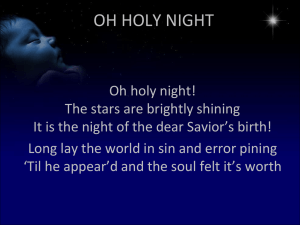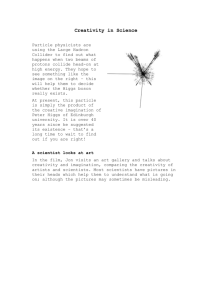Creative Imagination
advertisement

The Creative Imagination as Theophany Henry Corbin Excerpts From Alone With the Alone: Creative Imagination in the Sufism of Ibn ‘Arabi. [184] 1. The Creative Imagination as Theophany or the “God from Whom All Being Is Created” It will first be necessary to recall the acts of the eternal cosmogony as conceived by the genius of Ibn ‘Arabi.1 To begin with: a Divine Being alone in His unconditioned essence, of which we know only one thing: precisely the sadness of the primordial solitude that makes Him yearn to be revealed in beings who manifest Him to Himself insofar as He manifests Himself to them. That is the Revelation we apprehend. We must meditate upon it in order to know who we are. The leitmotiv is not the bursting into being of an autarchic Omnipotence, but a fundamental sadness: “I was a hidden Treasure, I yearned to be known. That is why I produced creatures, in order to be known in them.” This phase is represented as the sadness of the divine Names suffering anguish in nonknowledge because no one names them, and it is this sadness that descended in the divine Breath (tanaffus) which is Compassion (Rahma) and existentiation (ijad), and which in the world of the Mystery is the Compassion of the Divine Being with and for Himself, that is, for His own Names. Or, in other terms, the origin, the beginning is determined by love, which implies a movement of ardent desire (harakat shawqiya) on the part of him who is in love. This ardent desire is appeased by the divine Sigh.2 By an analysis in which he discovers the mystery of being in [185] the experience of his own being, the theosophist avoids from the outset the theological opposition between Ens increatum and an ens creatum drawn from nothingness, an opposition which makes it doubtful whether the relationship between the Summum Ens and the nothingness from which He causes creatures to arise has ever been truly defined. Sadness is not the “privilege” of the creature; it is in the Creator Himself, it is indeed the motif which, anticipating all our deductions, makes the primordial Being a creative Being; it is the secret of His creativity. And His creation springs, not from nothingness, from something other than Himself, from a notHim, but from His fundamental being, from the potencies and virtualities latent in His own unrevealed being. Accordingly, the word tanaffus also connotes “to shine,” “to appear” after the manner of the dawn. The Creation is essentially the revelation of the Divine Being, first to himself, a luminescence occurring within Him; it is a theophany (tajalli ilahi). Here there is no notion of a creatio ex nihilo opening up a gulf which no rational thought will ever be able to bridge because it is this profoundly divisive idea it- self which creates opposition and distance; here there is not so much as a fissure capable of growing into an area of uncertainty that no arguments or proofs can ever traverse. The Divine Breathing exhales what our shaikh designates as Nafas al-Rah-man or Nafas Rahmani, the Sigh of existentiating Compassion; this Sigh gives rise to the entire “subtile” mass of a primordial existentiation termed Cloud (‘ama). Which explains the following hadith: “Someone asked the Prophet: Where was your Lord before creating His (visible) Creation?—He was in a Cloud; there was no space either above or below.”8 This Cloud, which the Divine Being exhaled and in which He originally was, receives all forms and at the same time gives beings their forms; it is active and passive, receptive and existentiating (muhaqqiq); through it is effected the differentiation within the primordial reality of the being (haqiqat alwujud) that is the Divine Being as such (haqq fi dhatihi). As such, it [186] is the absolute unconditioned Imagination (khayal mutlaq) . The initial theophanic operation by which the Divine Being reveals Himself, “shows Himself” to Himself, by differentiating Himself in his hidden being, that is, by manifesting to Himself the virtualities of His Names with their correlata, the eternal hexeities of beings, their prototypes latent in His essence (a ‘yan thabita)4—this operation is conceived as being the creative Active Imagination, the theophanic Imagination. Primordial Cloud, absolute or theophanic Imagination, existentiating Compassion are equivalent notions, expressing the same original reality: the Divine Being from whom all things are created (al-Haqq al-makhluq bihi kull shay’)—which amounts to saying the “Creator-Creature.” For the Cloud is the Creator, since it is the Sigh He exhales and since it is hidden in Him; as such the Cloud is the invisible, the “esoteric” (batin). And it is the manifested creature (zahir). Creator-Creature (khaliq-makh-luq): this means that the Divine Being is the Hidden and the Revealed, or also that He is the First (al-Awwal) and the Last (al-Akhir).5 Thus in this Cloud are manifested all the forms of being from the highest Archangels, the “Spirits ecstatic with love” (al-muhayyamun), to the minerals of inorganic nature; everything that is differentiated from the pure essence of the Divine Being as such (dhat al-Haqq), genera, species and individuals, all this is created in the Cloud. “Created,” but not produced ex nihilo, since the only conceivable nonbeing is the latent state of beings, and since even in their state of pure potentiality, hidden within the unrevealed essence, beings have had a positive status (thubut) from pre-eternity. And indeed, “creation” has a negative aspect, since it puts an end to the privation of being which holds things in their occultation; this double nega- tivity, the nonbeing of a nonbeing, constitutes the positive act. In this sense it is permissible to say that the universe originates at once in being and in nonbeing.6 Thus Creation is Epiphany (tajalli), that is, a passage from [187] the state of occultation or potency to the luminous, manifest, revealed state; as such, it is an act of the divine, primordial Imagination. Correlatively, if there were not within us that same power of Imagination, which is not imagination in the profane sense of “fantasy,” but the Active Imagination (quwwat al-khayal) or Imaginatrix, none of what we show ourselves would be manifest. Here we encounter the link between a recur- rent creation, renewed from instant to instant, and an unceasing theophanic Imagination, in other words, the idea of a succession of theophanies (tajalliyat) which brings about the continuous succession of beings. This Imagination is subject to two possibilities, since it can reveal the Hidden only by continuing to veil it. It is a veil; this veil can become so opaque as to imprison us and catch us in the trap of idolatry. But it can also become increasingly transparent, for its sole purpose is to enable the mystic to gain knowledge of being as it is, that is to say, the knowledge that delivers, because it is the gnosis of salvation. This occurs when the gnostic understands that the plemulti successive forms, their movements and their actions, appear to be separate from the One only when they are veiled by a veil without transparency. Once transparency is achieved, he knows what they are and why they are; why there is union and discrimination between the Hidden and the Manifest; why there is the Lord and his vassal, the Worshiper and the Worshiped, the Beloved and the Lover; why any unilateral affirmation of a unity that confounds them, or of a discrimination that opposes their two existences as though they were not of the same essence, is a betrayal of the divine intention and hence of the Sadness which in each being yearns for appeasement in the manifestation of His secret. The Creature-Creator, the Creator who does not produce His creation outside Him, but in a manner of speaking clothes Himself in it as the Appearance (and transparency) beneath which He manifests and reveals Himself first of all to Himself, is referred to by several other names, such as the “imagined [188] God,” that is, the God “manifested” by the theophanic Imagination (al-Haqq al-mutakhayyal), the “God created in the faiths” (al-Haqq al-makhluq fi’l-i ‘tiqadat). To the initial act of the Creator imagining the world corresponds the creature imagining his world, imagining the worlds, his God, his symbols. Or rather, these are the phases, the recurrences of one and the same eternal process: Imagination effected in an Imagination (takhayyul fi takhayyul), an Imagination which is recurrent just as—and because—the Creation itself is recurrent. The same theophanic Imagination of the Creator who has revealed the worlds, renews the Creation from moment to moment in the human being whom He has revealed as His perfect image and who, in the mirror that this Image is, shows himself Him whose image he is. That is why man's Active Imagination can- not be a vain fiction, since it is this same theophanic Imagination which, in and by the human being, continues to reveal what it showed itself by first imagining it. This imagination can be termed “illusory” only when it becomes opaque and loses its transparency. But when it is true to the divine reality it reveals, it liberates, provided that we recognize the function with which Ibn ‘Arabi endowed it and which it alone can perform; namely, the function of effecting a coincidentia oppositorum (jam‘ bayna’l-naqidayn) . This term is an allusion to the words of Abu Sa‘id al-Kharraz, a celebrated Sufi master. “Whereby do you know God?” he was asked. And he replied: “By the fact that He is the coincidentia oppositorum.”7 For the entire universe of worlds is at once He and not-He (huwa la huwa). The God manifested in forms is at once Himself and other than Himself, for since He is manifested, He is the limited which has no limit, the visible which cannot be seen. This manifestation is neither perceptible nor verifiable by the sensory faculties; discursive reason rejects it. It is perceptible only by the Active Imagination (Hadrat al-Kkayal, the imaginative “Presence” or “Dignity,” the Imaginatrix) at times when it dominates man's sense perceptions, in dreams or better still [189] in the waking state (in the state characteristic of the gnostic when he departs from the consciousness of sensuous things). In short, a mystic perception (dhawq) is required. To perceive all forms as epiphanic forms (mazahir), that is, to perceive through the figures which they manifest and which are the eternal hexeities, that they are other than the Creator and nevertheless that they are He, is precisely to effect the encounter, the coincidence, between God's descent toward the creature and the creature's ascent toward the Creator. The “place” of this en- counter is not outside the Creator-Creature totality, but is the area within it which corresponds specifically to the Active Im- agination, in the manner of a bridge joining the two banks of a river.8 The crossing itself is essentially a hermeneutics of symbols (ta‘wil, ta‘bir), a method of understanding which transmutes sensory data and rational concepts into symbols (mazahir) by making them effect this crossing. An intermediary, a mediatrix: such is the essential function of the Active Imagination. We shall have more to say of it further on. The intellect (‘aql) cannot replace it. The First Intelligence (‘Aql awwal) is the first determination (ta‘ayyun awwal) that opens within the Cloud, which is itself the absolute theophanic Imagination. The intermediary between the world of Mystery (‘alam al-ghayb) and the world of visibility (‘alam al-shahadat) can only be the Imagination, since the plane of being and the plane of consciousness which it designates is that in which the Incorporeal Beings of the world of Mystery “take body” (which does not yet signify a material, physical body),8 and in which, reciprocally, natural, sensuous things are spiritualized or “immaterialized.” We shall cite examples to illustrate this doctrine. The Imagination is the “place of apparition” of spiritual beings, Angels and Spirits, who in it assume the figures and forms of their “apparitional forms”; and because in it the pure concepts (ma‘ani) and sensory data (mahsusat) meet and flower into personal figures prepared for the events of spiritual dramas, it is also the place where all “divine history” is accom-[190]plished, the stories of the prophets, for example, which have meaning because they are theophanies; whereas on the plane of sensory evidence on which is enacted what we call History, the meaning, that is, the true nature of those stories, which are essentially “symbolic stories,” cannot be apprehended. 2. The God Manifested by the Theophanic lmagination Mystic “cosmography” designates the intermediate world or plane of being specifically corresponding to the mediating function of the Imagination, as the luminous world of Idea-Images, of apparitional figures (‘alam mithali nurani). Ibn ‘Arabi's first preoccupation is with the connections between visions and on the one hand the imaginative faculty and on the other hand di- vine inspiration. For indeed, the entire metaphysical concept of the Imagination is bound up with the intermediate world. Here all the essential realities of being (haqa'iq al-wujad) are manifested in real Images; when a thing manifested to the senses or the intellect calls for a hermeneutics (ta‘wil) because it carries a meaning which transcends the simple datum and makes that thing a symbol, this symbolic truth implies a perception on the plane of the active Imagination. The wisdom which is concerned with such meanings, which makes things over as symbols and has as its field the intermediate world of subsisting Images, is a wisdom oflight (hikmat nuriya), typified in the person of Joseph, the exemplary interpreter of visions. Ibn ‘Arabi's metaphysics of the Imagination borrows a good many features of Suhrawardi's “Oriental theosophy.”10 The Active Imagination is essentially the organ of theophanies, because it is the organ of Creation and because Creation is essentially theophany. The Divine Being is a Creator because He wished to know Himself in beings who know Him; thus the Imagination cannot be characterized as “illusory,” because it is the organ and substance of this auto-revelation. Our mani-[191]fest being is the divine Imagination; our own Imagination is Imagination in His Imagination. The theosophy of Light suggests the metaphor of the mirror and the shadow. But “shadow” must not be taken to imply a dimension of Satanic darkness, an Ahrimanian antagonist; this shadow is essentially a reflection, the projection of a silhouette or face in a mirror. Our authors even speak of a “luminous shadow” (in the sense that color is shadow in the context of absolute Light: Zill al-nur as opposed to Zill alzulma, dark shadow). And that is how we must take the following statement: “Everything we call other than God, everything we call the universe, is related to the Divine Being as the shadow (or his reflection in the mirror) to the person. The world is God's shadow.''11 The function of Light as a cosmogonic agent begins in the world of Mystery. It is Light which reveals to the Divine Being the latent determinations and individuations contained in His essence, that is to say, the eternal hexeities which are the con- tents of the Divine Names. What these archetypes of virtual Creation receive is the shadow, the reflection, of the Divine Essence (dhat ilahiya) , projected upon them by the light of the Names. This is the first mirror in which the Divine Being contemplates Himself; He reveals Himself to Himself in the virtualities of His many Names. But the Names aspire to be fully revealed: this epiphany is the function of the Divine Name “Light” (Nur), whose epiphanic form (mazhar), to wit, sensuous light, the Sun, opens up the forms that correspond to these Names in the world of visibility (shahada). Light is the agent of the cosmogony, because it is the agent of Revelation, that is to say, of knowledge. Hence “we know the world only as we know shadows (or reflections); and we are ignorant of the Divine Being insofar as we are ignorant of the person who projects this shadow. The shadow is at once God and something other than God. Everything we perceive is the Divine Being in the eternal hexeities of the possibles.” And Ibn ‘Arabi con-[192]cludes: “Thus the world is pure representation (mutawahham), there is no substantial existence; that is the meaning of the Imagination. . . . Understand then who you are, understand what your selfhood is, what your relation is with the Divine Being; understand whereby you are He and whereby you are other than He, that is, the world, or whatever you may choose to call it. For it is in proportion to this knowledge that the degrees of preeminence among Sages are determined. “12 This suggests a reciprocal relationship: the relation of the shadow with the Divine Being is the Divine Being inaugurating the manifestation of the world of Mystery as absolute theophanic Imagination (khayiil mutlaq); the relation of the Divine Being to the shadow constitutes the individuations and personalizations of the Divine Being as God, who discloses Himself to and by the theophanic Imagination in the unlimited number of His Names. This process has been compared to the coloration of glass receiving light: the light is impregnated with a shadow which is the glass itself. And the twofold implication of the divine Names must also be taken into account. All these Names refer to one and the same Named One. But each one of them refers to an essential determination, different from all the rest; it is by this individualization that each Name refers to the God who reveals himself to and by the theophanic lmagination.13 To confine oneself to the plurality of the Names is to be with the divine Names and with the Names of the world. To confine oneself to the unity of the Named One is to be with the Divine Being in the aspect of His Self (dhat), independent of the world and of the relationships between His Names and the Names of the world. But the two stations are equally necessary; one conditions the other. To reject the first is to forget that the Divine Being reveals Himself to us only in the con- figurations of the theophanic Imagination, which gives an effective reality to those divine Names whose sadness yearned for concrete beings in whom to invest their activity, whom they have made what they are, beings thanks to whom and for whom [193] these Names have become hypostases, “Lords.” But to miss the second of the two stations is to fail to perceive the unity in plurality. To occupy both simultaneously is to be equidistant from polytheism and from monolithic, abstract and unilateral monotheism. To recognize the plurality that attaches to the Imagination is neither to devaluate it nor to negate it, but on the contrary to establish it. Similarly, he who is the servant of a divine Name is the shadow of that Name, his soul is its epiphanic form (mazhar). But in recognizing that this is so the servant does not negate his own existence. There is indeed a hadith concerning the servant who never ceases to move closer to his Lord; his Lord says of him: “I am his hearing by which he hears, his eyesight by which he sees. . . .” This servant does not become what he was not; what happens is that the “luminous shadow” becomes increasingly transparent. Moreover, the possessive adjective “his” refers explicitly to the reality of the servant or rather presupposes it.” These brief indications as to the twofold function of the theophanic Imagination as creative Imagination imagining the Creation and as creatural Imagination imagining the Creator, enable us to formulate a few thoughts that will serve as guides for the analyses that follow. (a) It is thanks to the Active Imagination that the multiple and the other exist, in short, that theophanies occur, so that the Active Imagination carries out the divine intention, the intention of the “Hidden Treasure” yearning to be known, to appease the distress of His Names. Any purely negative critique of the Imagination would be untenable, for it would tend to negate this revelation of God to Himself and to drive Him back into the solitude of nonknowledge, to refuse His Names the assistance they have expected of us since pre-eternity. And that is beyond the power of man. The most that man can do is to reject this revelation, that is, make himself incapable or unworthy of it. (b) Still, because what is Other than the Divine Being is [194] not absolutely other (a no without a yes), but is the very form of the theophany (mazhar) , the reflection or shadow of the being who is revealed in it, and because this form is Imagination, it announces something other, which is more than itself; it is more than appearance, it is apparition. And that is why a ta‘wil is possible, because there is symbol and transparency. This form itself presupposes an exegesis which carries it back to its source, or rather which apprehends simultaneously the many planes on which it is manifested. Without the Active Imagination the infinite exaltations provoked in a being by the succession of theophanies which that being bestows on himself would be impossible. (c) There is no ground for setting down the Active Imagination as illusion. The error consists in not seeing what it is, in supposing that the being it manifests is something added, something that subsists in itself outside the Divine Being. But it is through the Active Imagination that the manifested being becomes transparent. On the other hand, if the sensory data or the concepts of the intellect are taken at their face value and nothing more, as perfect expressions of what they have to “say,” and no more, if they are stripped of their symbolic function and therefore thought to have no need of a ta‘wil, in that case the world is raised to an autonomous status that does away with its theophanic transparency. (d) And such precisely is the God formulated by the intellect of the dogmatic theologians. Invested with the Names and Attributes held to be most worthy of Him, He is the Summum Ens, beyond which nothing more can be imagined. Divested of its transcendent function, the Active Imagination then seems to produce only the unreal, the “imaginary,” for it is isolated, just as a creature created ex nihilo is isolated from his Creator. In order to know in his heart that the Creator Himself has become creature because His Creation is the absolute Imagination, man must experience the human Imagination as an energy responding to the same creative need, the same creativity. Thus [195] in order to understand what the God manifested by the theophanic Imagination is, man must understand himself. To dogmatic rationalism this God may seem “imaginary”; and yet the God professed in this dogmatic faith is Himself raised to His truth only by the theophanic Imagination, which, because it sees Him in transparency, transmutes doctrine into symbol (mazhar). On this condition, the “God created in the faiths” can become a theophany for the heart.







